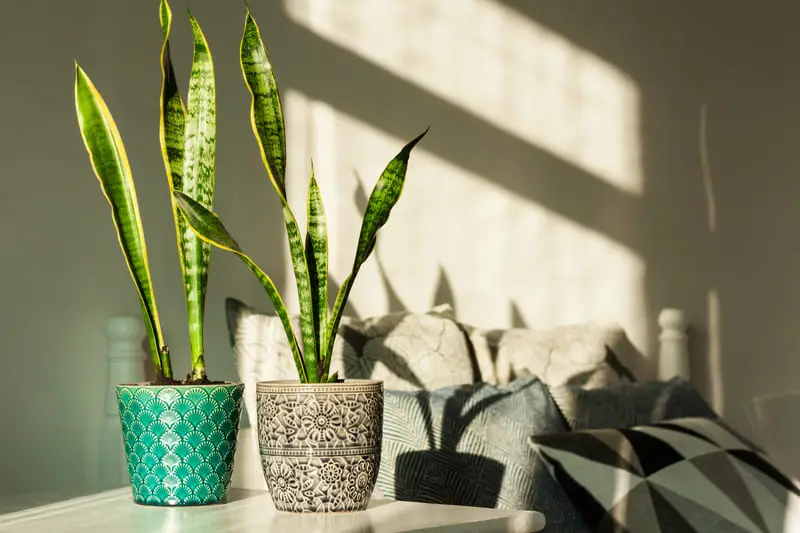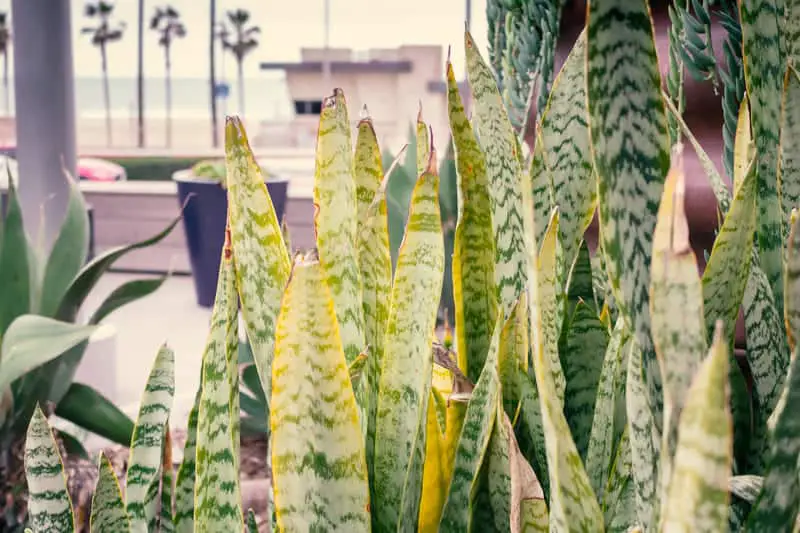The snake plant, commonly known as Sansevieria or the “Mother-in-law’s tongue” plant, is a perfect plant for beginners because it requires low maintenance and brings a lot of beauty and health benefits to your place.
If you consider getting one of these plants for your home, you will want to know how much light they need to thrive in your space.
The good news is that snake plants don’t need much light to grow into the beautiful, majestic plants you will love. They require a minimum of five hours of light in a day to develop well, and if you offer them more than that, they will thrive beautifully.
These plants do well in any light if not exposed to strong direct sunlight for hours a day. The amount of light a snake plant receives will impact how fast or slow it grows.
Can snake plants survive in low light?
Even if snake plants prefer indirect sunlight, they can still grow in low-light corners. However, the plant will grow slower if it receives less light, and you will have to water it according to the amount of light it receives and the climate.
Plants require less water in low-light areas and more in brighter, warmer areas. For instance, in a low-light space, you want to water your snake plant once every two weeks or even once a month if the soil is not getting dry faster.
Your snake plant will not thrive in a low-light environment, though. While it will still grow, it will mostly survive in such conditions rather than develop into the beautiful plant you want it to be.
Also check:Why Is My Snake Plant Drooping? (8 Major Reasons)
Can snake plants live in a dark room?
Thanks to its incredible adaptability, snake plants can still live in dark spaces where they receive no light at all. However, they will not live in such conditions for long as these plants still need some light, even if it is low light. They can’t survive for weeks in complete darkness.
To survive and grow, even at a slow speed, snake plants need a brightness of about 50-foot candles. But these conditions are minimum for the survival of your plant. If you want it to thrive and become a beautiful house plant, it needs at least 100-foot candle brightness.
Without any sunlight, your snake plant will not be able to complete the process of photosynthesis, and it will gradually wilt. You can still leave your snake plant in a dark room for a limited time, such as a month or six weeks. More than that, it might damage the plant and even kill it.
How often should you water a snake plant?
Snake plants can go without water for two to six weeks. The light and temperature of their environment and soil will influence how frequently you water them.
During the cold season, you might need to water your plant only once a month. Check the soil every two weeks to see how dry it is. You can do that by sticking a wooden stick inside the soil at a depth of one to two inches and seeing if it is humid or dry.
Don’t just check on the surface of the soil. If the soil is dry in less than a month, add water to the pot rather than the soil directly. Your plant will absorb the water it needs without rotting the roots.
During the summer, you want to water your snake plant every week or every two weeks. For the fall season, the average frequency for watering a snake plant is every three weeks.
Remember to check the soil every time before watering your snake plant. When trying to decide whether or not you should water the snake plant, remember that over-watering is more dangerous for these plants than under-watering it.
How much light does a snake plant need daily?
If you want your snake plant to grow healthy and beautiful, you must offer it at least five hours of indirect sunlight a day.
Even if your plant will survive in low light conditions, it needs five hours of natural light daily to produce its food and grow its leaves and new leaves that will embellish your space.
Placing your plant by a window covered with a sheer curtain will ensure the natural sunlight it needs in a day and even more.
But note that it is not recommended to leave your snake plant outdoors in direct sunlight during the hot season as its leaves will burn and lose their color. Stick to offering your plant indirect sunlight inside your house.
Can a snake plant live in a room with no windows?
While snake plants thrive near a window, they can survive in a room without windows. This quality makes snake plants ideal for offices and commercial spaces where windows are not always available.
However, these plants still need light, so ensure they receive artificial light for at least five hours a day. They will not thrive as they should if they don’t receive any natural light, but they will not die either.
How dark is too dark for a snake plant?
Complete darkness, with no natural or artificial light, is extreme and detrimental for snake plants. Despite their incredible ability to adjust to different conditions, these plants still require a form of light to survive.
How to make sure you offer your plant at least a low light environment rather than leave it in complete darkness. The brightness of a minimum of 50 foot-candles is mandatory for your plant’s survival.
However, remember that this light level is insufficient for your plant to grow healthy, tall, and beautiful.
What happens if the snake plant doesn’t get enough sun?
If your snake plant doesn’t receive enough sun, it will not have the energy it needs for photosynthesis, and therefore, it will not receive the food to grow.
Without enough sunlight, your snake plant will not only stop growing but also change the color of its leaves and slowly deteriorate and wilt.
How do you know if a snake plant is not getting enough light?
If you are unsure whether your snake plant is happy with the light it receives, there are a few signs you can look after. If you notice one or more of the following symptoms in your plant, gradually move it to a brighter space.
Moving the plant suddenly from a dark environment to a bright one is not recommended because it will create a shock and damage your plant. Instead of doing this transition fast, give it about a week to move it slowly towards the area with more abundant light.
Leaves change their color
The color of the leaves will change from yellow to brown, which might be the most obvious sign that your plant is not receiving the light it needs.
A healthy snake plant will have green leaves full of chlorophyll. Without proper light, the plant will consume all its resources to stay alive, as it cannot produce new food through adequate photosynthesis. Because of that, the leaves will lose their beautiful green color and fade into brownish shades.
Leaf dropping
Leaf dropping is also a sign of poor light exposure. Even if this could be a symptom of a disease or overwatering, the plant will drop the outer leaves to save energy for the younger leaves.
Instead of growing more leaves and thriving, the snake plant will do the opposite if you don’t offer it enough light.
Root rotting
Sunlight helps the soil dry out and evaporate the moisture, which keeps the plant’s roots healthy. If there is not enough sunlight, the soil will not dry properly, which will cause the roots to rot, and eventually, your plant will die.
Check the soil; if it remains moist for weeks, it is a clear sign that your snake plant needs more sunlight.
No new leaves
Without enough light for photosynthesis, your plant will be unable to produce new leaves, as it will struggle to nourish the ones it already has.
Snake plants reduce their growing speed during the winter in a natural way, but if you notice that your plant is still not growing during spring and summer, it might be due to a lack of light.
Even if the leaves didn’t change color and you didn’t notice any other alarming symptoms, you should still relocate your plant to a brighter area if it stopped growing.
Final thoughts
Snake plants can bring plenty of benefits to your space as they look fantastic when thriving and produce oxygen during the night. They filter the air around them and even remove pollutants.
If you suffer from allergies, snake plants are effective against their symptoms and can improve your life. This makes them ideal for bedrooms, and the fact that they are so low-maintenance is a plus.
But you still need to offer your plant the right amount of light and water to ensure it grows healthy and adds the qualities you want to your environment.




